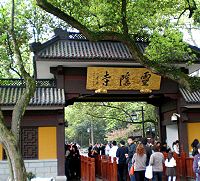Views
Língyǐn sì 靈隱寺
|
|
|
|
Língyǐn sì 靈隱寺 is one of the most famous temples in China, and the number one tourist attraction in Hángzhōu.
Contents |
History
Língyǐn Temple 靈隱寺 was originally founded by the Indian monk Huìlǐ 慧理 in 328 (Xiánhé 咸和 3) during the Eastern Jìn 東晉 Dynasty. The temple was at its peak during the Five Dynasties 五代 Period (10th c.), when its nearly 3,000 monastics lived and worked in 100 buildings on the site.
Although the temple has been destroyed more than ten times over the years, it has always been rebuilt. Most recently, the temple burned down in 1816 (Jiāqìng 嘉慶 21), and was rebuilt between 1823 and 1828 (Dàoguāng 道光 3 - 8). The main hall was expanded in 1910 (Xuāntǒng 宣統 2) and other renovations were carried out in the 1930s.
Língyǐn Temple has been an important center for monastic training over the centuries. In the modern period, it has served a crucial role in the early molding of some of the 20th century's important monks. Around 1905 Sū Mànshū 蘇曼殊 worked on the first Chinese-Sanskrit Dictionary here. Bǎojìng 寶靜 was tonsured here in 1915, as was Jùzàn 巨贊 in 1931.
Major renovations also took place in 1956 and 1975. During the Cultural Revolution, the temple was protected by students from Zhèjiāng University 浙江大學. As of 2001, this temple receives more visits from tourists each year than any other site in Hángzhōu. At that time it was estimated that it receives around 10,000 visitors/day.[1]
Personnel
Important Abbots
Notable Residents
- Bǎojìng 寶靜 (1915 - 1916)
- Jùzàn 巨贊 (1930 - 19333)
- Sū Mànshū 蘇曼殊 (1905 - 190?)
- Tánxuán 談玄 (1910s/1920s?)
Temple Institution
Important Buildings or Artifacts
Associated Organizations and Groups
Notes
- ↑ Sū, 179.
References
- Luó Zhéwén 羅哲文, et. al. Zhōngguó zhùmíng fójiào sìmiào 中國著名佛教寺廟 (Famous Buddhist Temples of China). Beijing: Zhongguo chengshi, 1995. Pp. 171-172.
- Sū Zhèshēng 蘇浙生. Shénzhōu fójìng 神州佛鏡 (Buddhist Regions of Shénzhōu). Shanghai: Shanghai guji, 2003. Pp. 177-179.
- 武林靈隱寺志 (1663 / Kāngxī 康熙 2, 1888 / Guāngxù 光緒 14 reprint), from Dharma Drum's Temple Gazetteer Project.
- Official Chinese website for the temple.
- Entry for 靈隱寺 from Chinese Wikipedia.
